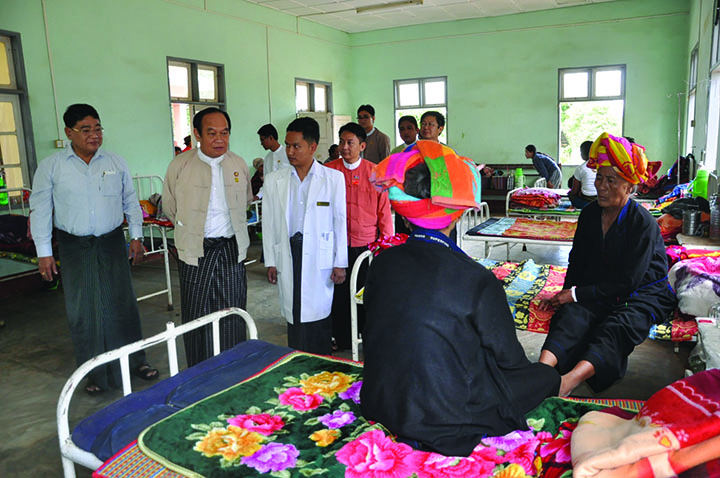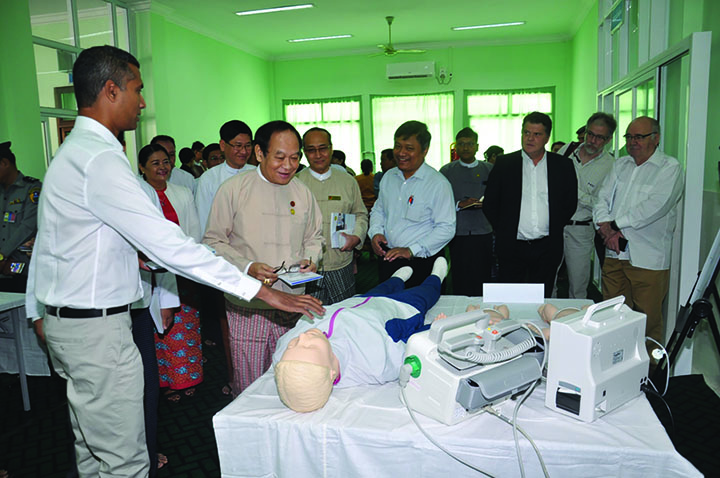The National Health Plan (2017-2020) mandated a distribution of 33 types of medicine worth K85 million, an ambulance and Type C laboratories worth K10 million each.
Union Minister Dr. Myint Htwe
By Khin Yadana
Photo: Aye Than
When the incumbent government came into power, two previous separate ministries were combined to create the Ministry of Health and Sports. The new team met with the Union Minister of MoHS Dr. Myint Htwe to talk about the various achievements of the Ministry throughout the 3rd year of the incumbent government.
Q: What are some notable achievements throughout the previous year?
A: We are only at 55% of the permitted workforce. We hired around 10,000 more community health workers from nurses to mid-wives to hospital managers. Around 1000 more hospitals got additional beds, totaling up to 55,266 new beds along with 200 more additional community health centers/clinics built across the country.
There were also 10,377 rooms built in the 2018-19 financial year to house our staff as well as plans to build more. The healthcare budget was increased when the new civilian government took over – the budget is currently K944 billion from the Union Government, K152 billion from international entities as well as K35.5 billion set to be loaned. From the budget, around K164 billion has been set to buy medical equipment and medicines.
Within 2018 alone, the public hospitals treated 3 million in-patients and 12 million out-patients with 760,000 surgeries operated. The community health centers/clinics in villages had an additional 14 million people seeking consultation and treatment. Every month, the centers/clinics provide care and guidance for 70,000-80,000 mothers. We also opened our Fertility center in the Central Women’s Hospital and successfully birthed our first test tube baby on 12 June 2018. The Ministry also spent K420 million to install a state-of-the-art tele-radiology X-ray machines in 3 townships in Mon State. If our budget allows, we will install these machines in Kachin and Kayah as well since these are really useful for people who live far from such facilities.
Q: What about improvements in laboratories and blood-donation banks?
A: The National Laboratory Department received 22 million Euros along with other Euros 5 million in funding for constructing a world-class laboratory. The laboratory performed 75,000 tests on pathology and 63,000 on microbiology. We are working with USCDC, WHO and groups from the UK to get the laboratory ISO 15189 certified. For blood donations, the Ministry was able to distribute 97,000 units of blood for free in 2018. We also opened our first Emergency Life Support Training Center in January 2019 which aims to educate doctors, nurses and all health professionals within the country to perform first-aid emergency response. The general hospitals also received additional pharmacies, restaurants and stores to accommodate the increasing patients’ guests. To help prevent public health emergencies, there are health clinics and emergency response teams in the highway buses stations where there is a lot of people in a confined space in Yangon city.

Q: Can you tell us a little bit about the National Health Plan?
A: The National Health Plan (2017-2020) mandated a distribution of 33 types of medicine worth K85 million, an ambulance and Type C laboratories worth K10 million each. We expect all townships to be covered by 2021. The Ministry is also rolling out the DHIS 2 software for health management system for early detection. There is about 665 hospitals using the software currently along with the township health departments for healthcare reporting.
Q: What about capability building in the healthcare sector staff?
A: The first step for the ministry was to distribute tablet phones which contains healthcare guides, emergency response plan and other procedural documents. There and already 11,000 tablets distributed throughout the country with 14,000 more planned from Gavi Vaccine Alliance. The information is also translated into 55 ethnic languages for distribution as booklets. Other health information is also posted on our public websites and social media sites and can be accessed online.
Q: What are some measures taken towards infectious diseases?
A: In 2012, 22.5 % of deaths in hospitals are caused by infections. The figure has been reduced to 14% by 2017. For HIV/AIDS, the Ministry is able to supply 166,121 patients with Antiretroviral Therapy (ART) available in 272 townships across the country. Additionally, we were able to test 1 million expectant mothers in 2018 for AIDS/HIV in an effort to prevent mother to child infections. Thanks to the public hospitals and clinics across the country, 135,435 TB patients were treated free of charge with 87% success rate. There are also 55 methadone dispensaries for drug users with plans to build 14 more. In 2016, there were 110,000 million people diagnosed with malaria. The number fell to 68,000 in 2018 with only 14 deaths in the whole country in the whole year. The main goal, of course, is to eradicate it. Dengue is also another concern with 13,000 diagnosed in 2018 with 112 deaths.
Vaccination programs for infants are also in full force with 11 types of vaccines distributed around the country. The Union spends around US$6.7 million every year to buy the necessary shots and is aiming for 100% coverage (we are currently at 80-90%). Rabies is also another priority. The ministry spent over K14 billion within the past three years for vaccine shots and treated almost 190,000 people who have been bitten. This significantly lowered death by rabies to 70 people in 2018 from 99 in 2016. Field Epidemiology Training Programs – FETP are also being held for public health workers and epidemiologists for practical training in preventing communicable diseases.
Q: What about collaborations with other international organizations?
A: We are working with several international organizations including: Global Fund, Gavi, Access to Health Fund, USAID, World Bank and ADB as well as UN organizations such as WHO, Unicef, UNDP, UNFPA, UNOPS and FAO. Others include TICA from Thailand, JICA from Japan and KOICA from Korea as well as 80 other INGOs from various different fields. We have an INGO profile book to keep track of all the INGOs active in the country with what they are working on. The Universities under the ministry also signed 75 MoUs with universities from 75 different countries.
Q: Can you explain to us about other improvements that are planned or is in progress such as human resource capability building?
A: We are trying our best to enforce laws for the safety of consumers regarding medicine and food. There has been post marketing surveillance tests on products that are already on the market with 6746 samples for food and 298 medicine samples tested last year in 2018. The FDA lab is also ISO/IEC 17025:2005 certified. The Ministry introduced a Mobile Lab Van which tours around the states and regions. It has been a great success- the vehicle has sampled 6200 food samples and 264 medicines over the course of 6 months that it has been deployed.
In 2017, there was a Healthy Myanmar Seminar held to encourage healthy living for Myanmar citizens. There were 13 decisions that came out of the seminar including training physical education teachers and installing outdoor fitness equipment over the state and regions.
Q: Any other tips for citizens to stay healthy?
A: There is actually a couple: try to reduce your alcohol, nicotine and betel nut intake, quit if you can; exercise regularly; reduce the sugar and sodium intake; use only FDA approved medicine; meditate; vaccinate your children; read about the health announcements and warnings and go to the hospital if you have any symptons.
(Translated by Myat Thu)


